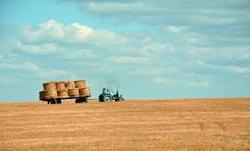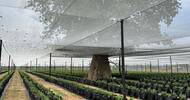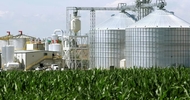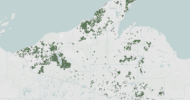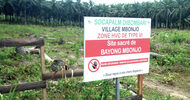Global AgInvesting | 11 March 2021
Maximizing the capture of returns, carbon, and duration in Canadian row crop land investments
By Stephen Johnston, Director, Veripath Partners
Introduction: Canada represents a farmland market of over 150 million acres with approximately 80 percent of that land in just three western provinces – Alberta, Manitoba, and Saskatchewan. Canada also has very large regional variations in prices, even for row-crop farmland. In addition, farmland is a provincial jurisdiction, and as a result, the regulations pertaining to ownership are not harmonized – ranging from fully open jurisdictions to provinces where only residents are able to hold title.
Canadian Farmland Returns: While Canadian farmland generally shares the behaviours of developed market farmland – consistent nominal and real rates of return, few drawdowns, portfolio diversifying effects, amongst others, there is another feature present in the Canadian market. It is one that is generally absent in other developed markets and we believe it will provide an additional source of returns for Canadian row crop land investments – a value proposition when productivity adjusted prices are considered.
Canadian Productivity Adjusted Pricing Advantage: The productivity adjusted pricing concept that we refer to normalizes for wheat. You take the absolute land price/acre and divide it by the annual productive capacity in tonnes of wheat. The result is the productivity adjusted price of the land – normalised to the price per tonne of wheat growing capacity. In practice this is a concept analogous to a PE ratio for a stock. Other metrics can be layered on top of course, such as historic yield volatility, yield trends, and others. But at the core, productivity adjusted pricing analysis allows a more standardised comparison across the various row crop markets found in Canada and the world. When it is applied to the Canadian market it becomes clear that the western prairie provinces (AB, SK and MB) trade at ~60 percent discount (~CAD$2,000/tonne) to global averages (~CAD$6,000 per tonne) with modest dispersion while the other large market in the east, Ontario, does not appear to be discounted, noting that Ontario does have a very wide productivity pricing dispersion– ~CAD$2,000tonne– ~CAD$10,000/tonne.
Canadian Sharpe Ratio Advantage: Another noticeable feature of the Canadian farmland investment thesis is very high realised Sharpe ratios. In the provinces of Ontario, Alberta, Saskatchewan, and Manitoba, an area representing approximately 90 percent of Canada’s farmland, Sharpe ratios have been as high as 1.9 (2008-2018). Compare this with typical public equity market ratios that are consistently less than 1. High Sharpe ratios are another indicator of the superior potential of Canadian row crop farmland investments.
Canadian Inflation/Stagflation Advantage: Farmland historically has had a significant positive correlation to inflation and stagflation. We took this analysis one step further and examined the effect of long-term real rates (10-year CAD bonds – CPI) on Canadian farmland appreciation behaviour. We created a cut-off into lower (lower than 4 percent) and higher real rate regimes (higher than 5 percent) and then analysed return data from 1970 to 2019. This series obviously includes the unique 1970s stagflation event (GDP contraction combined with highly accommodative fiscal and monetary policy – arguably conditions that exist today as well). By analyzing the data in this fashion rather than simply conducting a correlation analysis over the entire time series, Canadian farmland sensitivity to the real rate environment became apparent:
Low-Rate Periods – Real Rates < 4 percent
~ Average Annual Farmland Appreciation – 11.3 percent
~ Up Years as Percent of all Years – 97.1 percent
~ Average Size of Up Year – 11.7 percent
High-Rate Periods – Real Rates >= 5 percent
~ Average Annual Farmland Appreciation – -0.1 percent
~ Up Years as Percent of all Years – 26.7 percent
~ Average Size of Up Year – 5.7 percent
Carbon Sequestering Advantage: Another interesting feature of the Canadian farmland investment thesis relates to carbon capture and the penetration of zero-till/min-till technology in the AB/SK/MB markets. The high use of zero-till in these provinces leads to some interesting carbon sequestering benefits to potential investors in properly monitored portfolios of land in this region, even when compared to land in other parts of the Canadian market. To pursue this line of analysis, we created two theoretical Canadian farmland portfolios based on average land prices, zero-till uptake rates, and carbon sequestering capability per average acre to quantify potential carbon sequestering rates implicit in an underlying farmland investment:
~ Portfolio 1: 100,000 acres – 100 percent AB, SK & MB
~ Portfolio 2: 100,000 acres – 80 percent ON, 20 percent AB, SK & MB
We then used some high-level assumptions to estimate the carbon sequestered per each $10 million invested based on the following assumptions:
~ 70 percent of AB/SK/MB portfolio acres are zero-till
~ 25 percent of ON portfolio acres are zero-till
~ $2k per acre in AB/SK/MB
~ $8k per acre in ON
~ 0.33 tonnes carbon per acre sequestered by zero-till on average
The results were as follows:
~ Portfolio 1 – ~1,200 tonnes – equivalent to 260 passenger vehicles per year
~ Portfolio 2 – ~140 tonnes – equivalent to 30 passenger vehicles per year
Duration and Compliance Advantage: Investors trying to decide what developed world farmland market in which to allocate capital may want to consider another advantage the Canadian market can offer that may not be present elsewhere – the ability to participate via an open-ended structure. Most farmland investment vehicles take the traditional closed-ended private equity approach to capital. Funds are private, have finite defined lives with mandated liquidation and return of capital to investors. Though some are long-dated, no single fund with such a structure can accommodate the diverse duration requirement of investors seeking exposure to farmland. Institutional investors may need multi-decade exposure which an UHNW investor may want only a few years. Obviously, the longer the hold, the higher the probability that the value of the unique financial features of farmland will be realised – for example, the lack of correlation to traditional assets during a large market downturn or an episode of elevated inflation etc.
The best way to allow different durations to co-exist without moving to a publicly-traded structure (which can eliminate the portfolio diversification benefit) is to implement an open-ended vehicle where investors can choose how long they stay in the fund once the initial contractual hold period has passed. In addition, in Canada to simplify and streamline the compliance with all the various provincial regulatory regimes it is best to sub-divide the market into Saskatchewan and Manitoba in one allocation and Canada (excluding Saskatchewan and Manitoba) in the other. This approach achieves several goals – it opens the asset class to the widest range of potential investors including non-residents without sacrificing addressable market scale or return potential as SK/MB represent 84M acres and Canada ex SK/MB represents 84M acres with what we believe are investable productivity discounts in both target pools. It is for this purpose that Veripath has structured its investment platform in this fashion – open-ended using a pair of funds which sub-divide the Canadian market in SK/BM and Canada (ex SK/MB).
About the Author and Veripath: Stephen Johnston has over 25 years experience as a fund manager from the debt and private equity perspectives. As a senior fund manager at Société Générale Asset Management UK, Johnston oversaw the private equity portion of a series of closed-end funds investing across all sectors in the emerging markets of the former Soviet Union, Eastern Europe, the Baltics, and the Middle East. He has been involved in multiple funds investing into the Canadian alternative space with AUM approaching $1B in aggregate – including strategies deploying capital into farmland, private credit, energy, and SME PE. Johnston launched Canada’s first RRSP/TFSA eligible farmland investment vehicle and Veripath, one of Canada’s first open-ended farmland investment funds. He has a BSc. (1987) and a LLB from the University of Alberta (1990) and an MBA (1994) from the London Business School.
Veripath is a Canadian alternative investment firm. Members of Veripath’s management team have decades of farmland, private equity, and private credit investment experience. Veripath implements its farmland strategy in a way that seeks to preserve as far as possible farmland’s low-volatility return profile – the attribute that generates a material portion of Canadian farmland’s superior risk adjusted returns. Veripath does this by seeking to minimize operational, weather, geographic, and business-related risks – and capture the pure return from land appreciation. Veripath uses a unique split fund, evergreen structure which opens the Canadian farmland thesis to the largest possible universe of investors, and for the first time makes compliance with the various provincial farmland ownership regulations simple and straightforward. Canadian farmland allocations have several compelling characteristics that make them a worthwhile portfolio allocation for both institutional and retail investors and Veripath’s structures are available to both. For more information on Veripath please feel free to register online at www.veripathfarmland.com.


